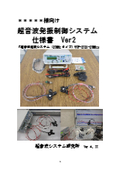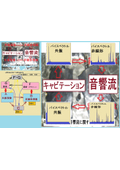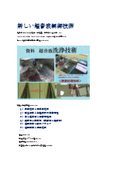Technology for controlling nonlinear phenomena of ultrasound.
The Ultrasonic System Research Institute has developed a technology for controlling "nonlinear phenomena of ultrasound (acoustic flow)" using indirect containers. This technology utilizes (evaluates) the ultrasonic propagation characteristics (analysis results) of indirect containers, ultrasonic water tanks, and other items to control ultrasound (cavitation and acoustic flow). Furthermore, it realizes effective ultrasonic (cavitation and acoustic flow) propagation states tailored to the structure, material, and acoustic characteristics of specific target objects, by controlling the oscillation of ultrasound in accordance with the interactions between glass containers, ultrasound, and target objects. In particular, the dynamic characteristics of harmonics through acoustic flow control enable responses at the nanoscale. This has been applied and developed from examples of dispersing metal powders to nanosize. By employing control technologies for standing waves and cavitation in relation to ultrasound, as well as propagation control technologies for indirect containers, we can appropriately control cavitation and acoustic flow. Through original measurement and analysis techniques for ultrasonic propagation states, we have confirmed the evaluation of acoustic flow and numerous know-how.
Inquire About This Product
basic information
"Control of Acoustic Flow and Cavitation Using Indirect Containers" The technology developed this time utilizes the propagation characteristics of ultrasound to set and control water tanks, indirect containers, liquids, and liquid circulation, enabling the use of ultrasonic effects across a wide range of ultrasonic propagation frequencies that differ from the oscillation frequency of ultrasonic devices. In particular, by considering the acoustic properties of the container, it has become possible to control the effects of acoustic flow. <Specific Examples> Using a 28 kHz ultrasonic transducer and a glass container for ultrasonic cleaning at 100 Hz - 700 kHz. Using a 40 kHz ultrasonic transducer and a stainless steel container for ultrasonic dispersion at 600 Hz - 3200 kHz. Using a 72 kHz ultrasonic transducer and a resin container for surface treatment at 72 kHz - 7 MHz. These are examples of implementation. Furthermore, through the "Evaluation Technology for Ultrasonic Devices" from the Ultrasonic System Research Institute, the specific effects have been quantified and graphed to confirm the acoustic properties of indirect containers (various treatment tools). Ultrasound Propagation Characteristics: 1) Detection of Vibration Modes 2) Detection of Nonlinear Phenomena 3) Detection of Response Characteristics 4) Detection of Interactions
Price information
Feel free to contact us.
Delivery Time
※Feel free to contact us.
Applications/Examples of results
2008. 8 Established the Ultrasonic System Research Institute ... 2012. 1 Started manufacturing and selling ultrasonic measurement and analysis systems (Ultrasonic Tester NA) ... 2020. 5 Patent application for flow-type ultrasonic cleaning machine 2020. 11 Started surface treatment consulting services ... 2024. 4 Developed optimization technology for resonance phenomena and nonlinear phenomena 2024. 5 Developed optimization technology related to the combination of sound and ultrasound 2024. 6 Developed optimization and evaluation technology concerning water tanks, ultrasound, and liquid circulation 2024. 7 Developed ultrasonic probe using components with iron plating on polyimide film 2024. 8 Developed "megahertz ultrasonic control" method applying Shannon's juggling theorem 2024. 9 Developed acoustic flow control technology using portable ultrasonic cleaners 2024. 10 Developed "vibration technology" using megahertz ultrasound 2024. 10 Developed ultrasonic oscillation control probe using stainless steel vacuum double-structure container 2024. 11 Developed megahertz flow-type ultrasonic (underwater shower) technology 2024. 11 Developed ultrasonic sound pressure data analysis and evaluation technology considering interaction and response characteristics
Detailed information
-

Ultrasonic control technology using indirect containers
-

Ultrasonic control technology using indirect containers
-

Ultrasonic control technology using indirect containers
-

Ultrasonic control technology using indirect containers
-

Ultrasonic control technology using indirect containers
-

Ultrasonic control technology using indirect containers
-

Ultrasonic control technology using indirect containers
-

Ultrasonic control technology using indirect containers
-

Ultrasonic control technology using indirect containers
catalog(15)
Download All Catalogs





News about this product(15)
Company information
The Ultrasonic System Research Institute conducts the following activities with its original product: ultrasonic systems (sound pressure measurement analysis, oscillation control): 1) Manufacturing and sales of ultrasonic systems (sound pressure measurement analysis, oscillation control) 2) Consulting services for various equipment (Note): cleaning machines, stirring devices, processing equipment, machine tools, plating devices, welding devices, etc. Ultrasonic System (Sound Pressure Measurement Analysis, Oscillation Control) We manufacture and sell a system that combines the "Ultrasonic Tester NA (recommended type)" for easy measurement and analysis of ultrasonic waves and the "Ultrasonic Oscillation System (1 MHz, 20 MHz)" for easy oscillation control. <Patent Applications Filed> Patent Application No. 2021-125866: Ultrasonic Control (Ultrasonic Oscillation Control Probe) Patent Application No. 2021-159990: Ultrasonic Welding Patent Application No. 2021-161532: Ultrasonic Plating Patent Application No. 2021-171909: Ultrasonic Processing Patent Application No. 2021-175568: Flow-type Ultrasonic Cleaning Some of the manufacturing technology for the ultrasonic oscillation control probe is described in Patent Application No. 2021-125866. Patent Application No. 2023-195514: Ultrasonic Plating Using Megahertz Ultrasonic Waves and Fine Bubbles.














